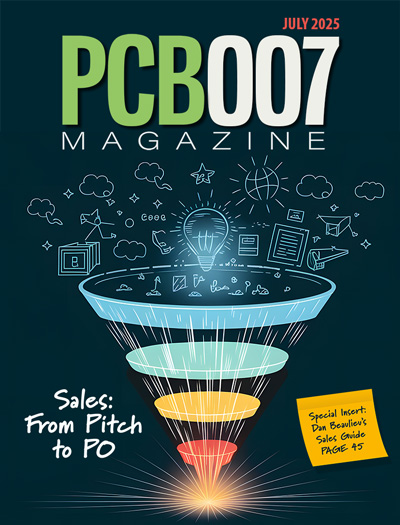-

- News
- Books
Featured Books
- pcb007 Magazine
Latest Issues
Current Issue
Advancing the Advanced Materials Discussion
Moore’s Law is no more, and the advanced material solutions to grapple with this reality are surprising, stunning, and perhaps a bit daunting. Buckle up for a dive into advanced materials and a glimpse into the next chapters of electronics manufacturing.

Inventing the Future With SEL
Two years after launching its state-of-the-art PCB facility, SEL shares lessons in vision, execution, and innovation, plus insights from industry icons and technology leaders shaping the future of PCB fabrication.

Sales: From Pitch to PO
From the first cold call to finally receiving that first purchase order, the July PCB007 Magazine breaks down some critical parts of the sales stack. To up your sales game, read on!
- Articles
- Columns
- Links
- Media kit
||| MENU - pcb007 Magazine
Tracing the Light Inside LEDs Higher Efficiency
September 14, 2017 | University of TwenteEstimated reading time: 2 minutes
White LEDs can be made even more efficient and powerful, photonics researchers of the University of Twente and Philips Lighting now prove. They found a detailed way for describing the light that stays inside the LED by absorption and scattering. This is very valuable information for the design process.
From relatively weak light sources to strong lights at home and in cars, for example : since the blue and white LED were invented, we’ve seen a rapid development in possible applications. Low energy consumption and long lifetime are major advantages over existing lighting solutions. White LEDs consist of a semiconductor emitting blue light, with on top of that phosphor plates that turn the blue light into yellow. What we see then, is white light. The light will be scattered by the phosphor particles, but part of it is absorbed as well. What part of the light will exit the LED, is not easy to predict. Unless you look at absorption and scattering in another way, according to Maryna Meretska and her colleagues. Theory from astronomy helps.
Detailed and fast
What makes good prediction particularly difficult: some of the light is absorbed, but re-emitted in another colour. One way is trying to define all possible light rays, and use a lot of computing time to get a result. This doesn’t give much insight in what is actually happening. A theory that is often used for light propagation in a LED, is diffusion theory. In strongly absorbing media, however, this approach isn’t valid anymore. Meretska therefore has built a setup to collect all the light around the phosphor plates, in the whole visual spectrum. Based on this, absorption and scattering can be deduced using the radiative transfer equation, well known in astronomy. This results in a full description of light propagation inside and outside the phosphor plates. Compared to a description using diffusion theory, the absorption level is up to 30 percent higher. At the same time, the method is about 17 times faster than the numerical approach.
Absorption: blue is based on diffusion theory, red is the new method, black is a numerical 'Monte Carlo' check.
These new insights, and their level of detail, can lead to powerful and predictive tools for LED designers. They help in further improving the efficiency.
Photonics
The research has been done in the Complex Photonic Systems group of UT’s MESA+ Institute for Nanotechnology, together with Philips Lighting in Eindhoven. The University of Twente has a strong concentration of research groups and facilities in the rapidly growing field of photonics.
The paper ‘Analytical modeling of light transport in scattering materials with strong absorption’ by Maryna Meretska, Ravitej Uppu, Gilles Vissenberg, Ad Lagendijk, Wilbert IJzerman and Willem Vos, will appear in Optics Express, one of the leading journals of the Optical Society. It is already online.
Testimonial
"The I-Connect007 team is outstanding—kind, responsive, and a true marketing partner. Their design team created fresh, eye-catching ads, and their editorial support polished our content to let our brand shine. Thank you all! "
Sweeney Ng - CEE PCBSuggested Items
Defense Speak Interpreted: The Autonomous Plane Battle—Skyborg Vs. Loyal Wingman
10/07/2025 | Dennis Fritz -- Column: Defense Speak InterpretedI’m awaiting the updates for the U.S. Air Force's Skyborg and Loyal Wingman airborne driverless vehicles. As the hype of self-driving cars has given way to more mundane autonomous activities, so too has the hype of uncrewed planes given way to reality. In cars, the SAE International association classifies degrees of autonomy from 0 to 5, as do some defense aerospace applications of unmanned flight, which have been reduced to practice, while others remain under development.
STMicroelectronics' STARLight Project to Lead EU Silicon Photonics on 300mm Wafers
09/23/2025 | STMicroelectronicsThe STARLight project brings together a consortium of leading industrial and academic partners to position Europe as a technology leader in 300mm silicon photonics (SiPho) technology by establishing a high-volume manufacturing line, developing leading-edge optical modules, and fostering a complete value chain.
Curing and Verification in PCB Shadow Areas
09/17/2025 | Doug Katze, DymaxDesign engineers know a simple truth that often complicates electronics manufacturing: Light doesn’t go around corners. In densely populated PCBs, adhesives and coatings often fail to fully cure in shadowed regions created by tall ICs, connectors, relays, and tight housings.
VIDEOTON EAS's Bulgarian Subsidiary Expands Into Automotive Products
09/15/2025 | VideotonVEAS Bulgaria, engaged in electronics manufacturing, has joined the ranks of VIDEOTON companies authorized to produce automotive products.
Dymax Mexico to Showcase Light-Curing Technologies at SMTA Guadalajara Expo & Tech Forum 2025
09/05/2025 | DymaxDymax, a global manufacturer of rapid light-curing materials and equipment, will participate in SMTA Guadalajara Expo & Tech Forum, taking place September 17-18, 2025, at the Guadalajara Expo Center in Guadalajara, Jalisco, Mexico.


